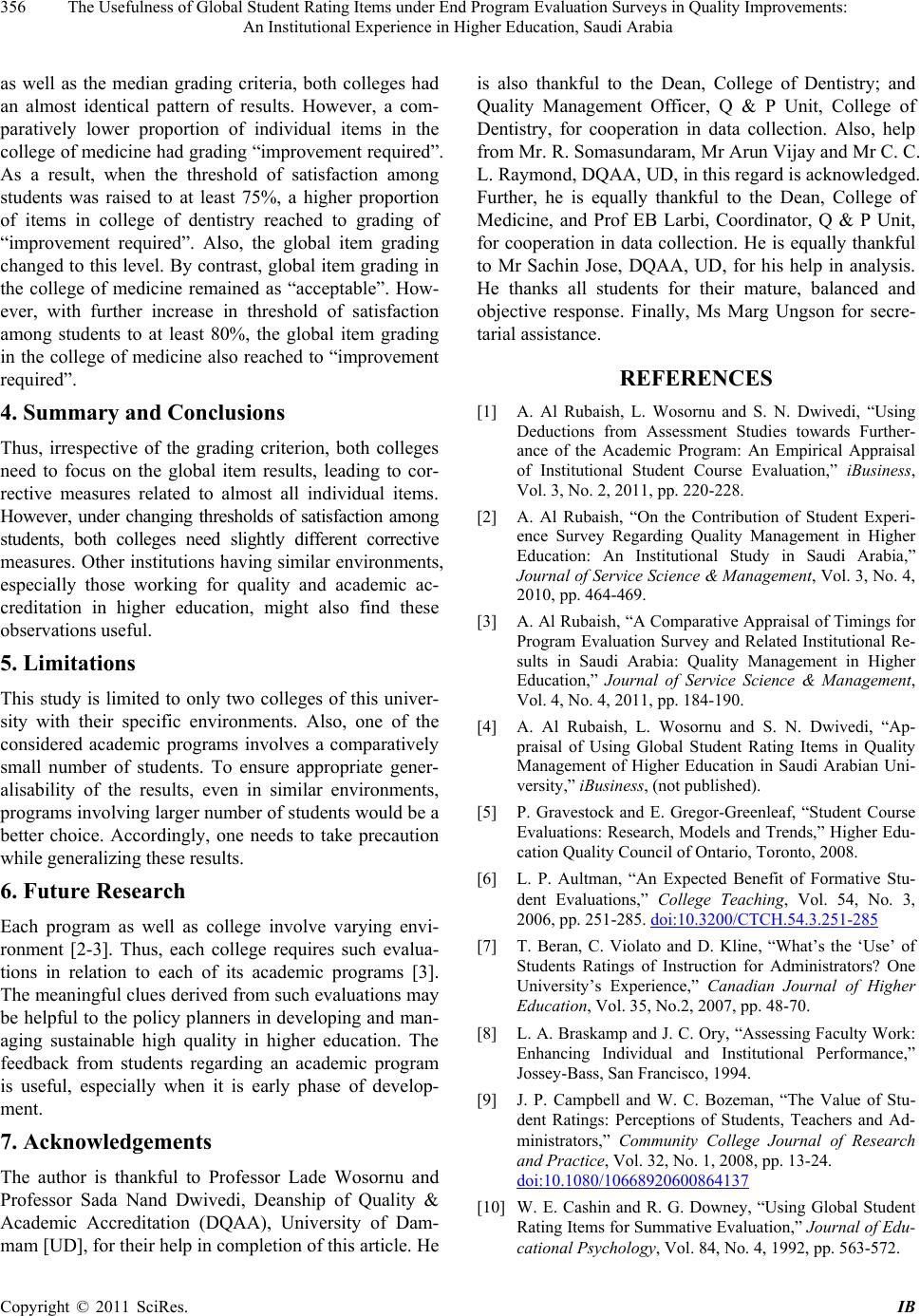
The Usefulness of Global Student Rating Items under End Program Evaluation Surveys in Quality Improvements:
356 An Institutional Experience in Higher Education, Saudi Arabia
as well as the median grading criteria, both colleges had
an almost identical pattern of results. However, a com-
paratively lower proportion of individual items in the
college of medicine had grading “improvement required”.
As a result, when the threshold of satisfaction among
students was raised to at least 75%, a higher proportion
of items in college of dentistry reached to grading of
“improvement required”. Also, the global item grading
changed to this level. By contrast, global item grading in
the college of medicine remained as “acceptable”. How-
ever, with further increase in threshold of satisfaction
among students to at least 80%, the global item grading
in the college of medicine also reached to “improvement
required”.
4. Summary and Conclusions
Thus, irrespective of the grading criterion, both colleges
need to focus on the global item results, leading to cor-
rective measures related to almost all individual items.
However, under changing thresholds of satisfaction among
students, both colleges need slightly different corrective
measures. Other institutions having similar environments,
especially those working for quality and academic ac-
creditation in higher education, might also find these
observations useful.
5. Limitations
This study is limited to only two colleges of this univer-
sity with their specific environments. Also, one of the
considered academic programs involves a comparatively
small number of students. To ensure appropriate gener-
alisability of the results, even in similar environments,
programs involving larger number of students would be a
better choice. Accordingly, one needs to take precaution
while generalizing these results.
6. Future Research
Each program as well as college involve varying envi-
ronment [2-3]. Thus, each college requires such evalua-
tions in relation to each of its academic programs [3].
The meaningful clues derived from such evaluations may
be helpful to the policy planners in developing and man-
aging sustainable high quality in higher education. The
feedback from students regarding an academic program
is useful, especially when it is early phase of develop-
ment.
7. Acknowledgements
The author is thankful to Professor Lade Wosornu and
Professor Sada Nand Dwivedi, Deanship of Quality &
Academic Accreditation (DQAA), University of Dam-
mam [UD], for their help in completion of this article. He
is also thankful to the Dean, College of Dentistry; and
Quality Management Officer, Q & P Unit, College of
Dentistry, for cooperation in data collection. Also, help
from Mr. R. Somasundaram, Mr Arun Vijay and Mr C. C.
L. Raymond, DQAA, UD, in this regard is acknowledged.
Further, he is equally thankful to the Dean, College of
Medicine, and Prof EB Larbi, Coordinator, Q & P Unit,
for cooperation in data collection. He is equally thankful
to Mr Sachin Jose, DQAA, UD, for his help in analysis.
He thanks all students for their mature, balanced and
objective response. Finally, Ms Marg Ungson for secre-
tarial assistance.
REFERENCES
[1] A. Al Rubaish, L. Wosornu and S. N. Dwivedi, “Using
Deductions from Assessment Studies towards Further-
ance of the Academic Program: An Empirical Appraisal
of Institutional Student Course Evaluation,” iBusiness,
Vol. 3, No. 2, 2011, pp. 220-228.
[2] A. Al Rubaish, “On the Contribution of Student Experi-
ence Survey Regarding Quality Management in Higher
Education: An Institutional Study in Saudi Arabia,”
Journal of Service Science & Management, Vol. 3, No. 4,
2010, pp. 464-469.
[3] A. Al Rubaish, “A Comparative Appraisal of Timings for
Program Evaluation Survey and Related Institutional Re-
sults in Saudi Arabia: Quality Management in Higher
Education,” Journal of Service Science & Management,
Vol. 4, No. 4, 2011, pp. 184-190.
[4] A. Al Rubaish, L. Wosornu and S. N. Dwivedi, “Ap-
praisal of Using Global Student Rating Items in Quality
Management of Higher Education in Saudi Arabian Uni-
versity,” iBusiness, (not published).
[5] P. Gravestock and E. Gregor-Greenleaf, “Student Course
Evaluations: Research, Models and Trends,” Higher Edu-
cation Quality Council of Ontario, Toronto, 2008.
[6] L. P. Aultman, “An Expected Benefit of Formative Stu-
dent Evaluations,” College Teaching, Vol. 54, No. 3,
2006, pp. 251-285. doi:10.3200/CTCH.54.3.251-285
[7] T. Beran, C. Violato and D. Kline, “What’s the ‘Use’ of
Students Ratings of Instruction for Administrators? One
University’s Experience,” Canadian Journal of Higher
Education, Vol. 35, No.2, 2007, pp. 48-70.
[8] L. A. Braskamp and J. C. Ory , “Assessing Faculty Work:
Enhancing Individual and Institutional Performance,”
Jossey-Ba ss, San Francisco, 1994.
[9] J. P. Campbell and W. C. Bozeman, “The Value of Stu-
dent Ratings: Perceptions of Students, Teachers and Ad-
ministrators,” Community College Journal of Research
and Practice, Vol. 32, No. 1, 2008, pp. 13-24.
doi:10.1080/10668920600864137
[10] W. E. Cashin and R. G. Downey, “Using Global Student
Rating Items for Summative Evaluation,” Journal of Edu-
cational Psychology, Vol. 84, No. 4, 1992, pp. 563-572.
Copyright © 2011 SciRes. IB